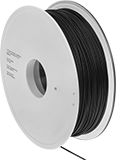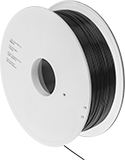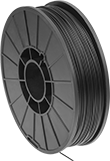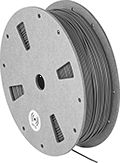Easy-to-Print PLA 3D Printer Filaments

The most commonly used 3D printing material, these PLA filaments make detailed parts at a low melting point, so they won’t warp as they cool, rarely clog nozzles, and don’t require a heated printer bed. They’re also unlikely to drip and produce plastic strings for a clean finished part. In general, they’re best for printing prototypes instead of load-bearing parts since they’re not as strong as ABS or as heat resistant as PEEK. Print them on a fused filament fabrication (FFF) 3D printer.
Expose parts made with glow-in-the-dark PLA filaments to ambient light and they will stay visible in the dark. Use these filaments to create machine switches and handles or custom signs and labels that can be seen in low-light conditions. Because they’re abrasive, you should only use them with abrasion-resistant nozzles.
Filaments with an annealing temperature can be heat treated to make parts harder, stronger, and better at resisting heat. To anneal, heat your finished part to the listed temperature and then let it cool slowly.
Tensile strength is the best measure of a filament’s overall strength. Similar to the stress applied on a rope during a game of tug-of-war, it’s the amount of pulling force a material can handle before breaking. A higher rating means a stronger filament. A tensile strength of 5,000 psi and above is considered good; 12,000 psi and above is excellent.
Maximum exposure temperature is the point at which a printed part will begin to deform. Above this temperature, your part will start to lose structural integrity. Filaments that can be annealed are also rated for maximum temperature after annealing, which is the new maximum exposure temperature once that process completes.
Spool | Each | ||||||||||||
|---|---|---|---|---|---|---|---|---|---|---|---|---|---|
| Dia., mm | Printing Temp. | For Printer Bed Temp. | Tensile Strength | Max. Exposure Temp. | Annealing Temp. | Max. Temp. After Annealing | For Min. Nozzle Dia., mm | Dia., mm | Dp., mm | Wt., g | 1-9 | 10-Up | |
PLA Plastic | |||||||||||||
Opaque Green | |||||||||||||
| 1.75 | 190° to 220° C 374° to 428° F | 25° to 60° C 77° to 140° F | 3,840 psi (Poor) | 59° C 138° F | __ | __ | 0.4 | 200 | 65 | 1,000 | 00000000 | 000000 | 000000 |
| 1.75 | 190° to 230° C 374° to 446° F | 0° to 70° C 32° to 158° F | 9,500 psi (Good) | 60° C 140° F | 110° to 120° C 230° to 248° F | 130° C 266° F | 0.4 | 200 | 91 | 1,000 | 00000000 | 00000 | 00000 |
| 2.85 | 190° to 230° C 374° to 446° F | 0° to 70° C 32° to 158° F | 9,500 psi (Good) | 60° C 140° F | 110° to 120° C 230° to 248° F | 130° C 266° F | 0.4 | 200 | 91 | 1,000 | 00000000 | 00000 | 00000 |
Glow-in-the-Dark PLA Plastic | |||||||||||||
Opaque Green | |||||||||||||
| 1.75 | 190° to 230° C 374° to 446° F | 25° to 60° C 77° to 140° F | 6,620 psi (Good) | 61° C 141° F | __ | __ | 0.4 | 200 | 65 | 1,000 | 0000000 | 00000 | 00000 |
Impact-Resistant ABS 3D Printer Filaments

Bumps, scrapes, and falls won’t damage these tough ABS filaments. Known for their durability, they absorb impact without cracking or breaking, and won’t degrade when heated. Use them to print tool handles, storage cases, and other parts that are handled or dropped frequently. These filaments are a good place to start if you’re experimenting with printing impact-resistant parts.
Use with a fused filament fabrication (FFF) 3D printer. These filaments have a high melting point and must be printed onto a heated bed. Without it, parts will cool too quickly and warp. These filaments also release fumes as they are printed, so use an enclosed printer or a fume exhauster to ventilate them.
Tensile strength is the best measure of a filament's overall strength. Similar to the stress applied on a rope during a game of tug-of-war, it's the amount of pulling force a material can handle before breaking. A higher rating means a stronger filament. A tensile strength of 5,000 psi and above is considered good; 12,000 psi and above is excellent.
Maximum exposure temperature is the point at which a printed part will begin to deform. Above this temperature, your printed parts will start to lose structural integrity.
Spool | |||||||||||
|---|---|---|---|---|---|---|---|---|---|---|---|
| Dia., mm | Printing Temp. | For Printer Bed Temp. | Tensile Strength | Max. Exposure Temp. | For Min. Nozzle Dia., mm | Dia., mm | Dp., mm | Wt., g | Color | Each | |
ABS Plastic | |||||||||||
| 1.75 | 220° to 240° C 428° to 464° F | 100° to 110° C 212° to 230° F | 6,090 psi (Good) | 90° C 194° F | 0.25 | 195 | 75 | 1,000 | Green | 00000000 | 000000 |
Flexible TPU 3D Printer Filaments
 | ||||
Stretchy, soft, and sturdy, these filaments make durable parts that resist breakage despite repeated use. Stronger than ABS and PLA filaments, they create long-lasting parts, such as seals, sleeves, and gaskets, as well as components that take on high-impact forces, such as springs and snap-fit parts. These filaments don't require a heated printer bed, and they won't shrink or warp when cooling. Use them with a fused filament fabrication (FFF) 3D printer. In general, these flexible filaments require a slow feed rate so they don't jam. The softer your filament, the slower your feed rate will need to be. Store them in a sealed container with a desiccant, or use a dehumidifying cabinet, since ambient humidity will cause the plastic to degrade and weaken.
For the most flexible parts, use durometer 85A filaments. They're more flexible than other TPU filaments. For a quick print without sacrificing flexibility, choose durometer 95A filaments. They print much faster than other TPU filaments.
Tensile strength is the best measure of a filament's overall strength. Similar to the stress applied on a rope during a game of tug-of-war, it's the amount of pulling force a material can handle before breaking. A higher rating means a stronger filament. A tensile strength of 5,000 psi and above is considered good; 12,000 psi and above is excellent.
Maximum exposure temperature is the point at which a printed part will begin to deform. Above this temperature, your printed parts will start to lose structural integrity.
Spool | |||||||||||
|---|---|---|---|---|---|---|---|---|---|---|---|
| Dia., mm | Printing Temp. | For Printer Bed Temp. | Tensile Strength | Max. Exposure Temp. | For Min. Nozzle Opening Dia., mm | Dia., mm | Dp., mm | Wt., g | Color | Each | |
TPU Plastic—Durometer 85A (Medium Soft) | |||||||||||
| 1.75 | 225° to 235° C 437° to 455° F | 21° to 40° C 70° to 104° F | 580 psi | 44° C 111° F | 0.25 | 200 | 70 | 1,000 | Opaque Green | 00000000 | 000000 |
| 2.85 | 225° to 235° C 437° to 455° F | 21° to 40° C 70° to 104° F | 580 psi | 44° C 111° F | 0.25 | 200 | 70 | 1,000 | Opaque Green | 00000000 | 00000 |
TPU Plastic—Durometer 95A (Medium Soft) | |||||||||||
| 1.75 | 230° to 240° C 446° to 464° F | 21° to 40° C 70° to 104° F | 1,250 psi | 49° C 120° F | 0.25 | 200 | 70 | 1,000 | Opaque Green | 00000000 | 00000 |
| 2.85 | 230° to 240° C 446° to 464° F | 21° to 40° C 70° to 104° F | 1,250 psi | 49° C 120° F | 0.25 | 200 | 70 | 1,000 | Opaque Green | 00000000 | 00000 |
Dremel 3D Printer Filaments

Build parts and prototypes from these filaments using Dremel fused filament fabrication (FFF) 3D printers. An RFID tag on the spool communicates with your printer, automatically adjusting it to the correct temperature and print speed for the filament material and notifying you when the filament is running out.
PLA filaments are the most commonly used in 3D printing. PLA is easy to use; it rarely clogs nozzles, doesn’t require a heated printer bed, and prints at a low temperature—meaning parts won’t warp while cooling. It produces string-free parts, so you can use it to print with a high level of detail. Less durable and more sensitive to heat than ECO-ABS, PLA is better for printing prototypes than end-use parts.
Tensile strength is the best measure of a filament's overall strength. Similar to the stress applied on a rope during a game of tug-of-war, it's the amount of pulling force a material can handle before breaking. A higher rating means a stronger filament. A tensile strength of 5,000 psi and above is considered good; 12,000 psi and above is excellent.
Maximum exposure temperature is the point at which a printed part will begin to deform. Above this temperature, your printed parts will start to lose structural integrity.
Spool | |||||||||||
|---|---|---|---|---|---|---|---|---|---|---|---|
| Dia., mm | Printing Temp. | For Printer Bed Temp. | Tensile Strength | Max. Exposure Temp. | For Min. Nozzle Opening Dia., mm | Dia., mm | Dp., mm | Wt., g | Color | Each | |
PLA Plastic | |||||||||||
| 1.75 | 200° to 230° C 395° to 445° F | 35° C 95° F | 6,620 psi (Good) | 60° C 140° F | 0.25 | 180 | 55 | 750 | Green | 000000 | 000000 |



























